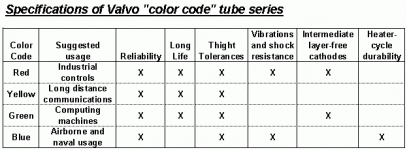Does anyone have tube tester parameters for this tube? A friend of mine has a bunch that he wants to test. He has a Hickock 539 and a military TV-10. I have a TV-7 and a Hickock 123 Card-Matic.
John
John
Well, the pin-out is the same as an E88CC, mu and gm are pretty similar but it's a bit beefier, so testing as an E88CC would be a start. Frank's pages have a data sheet.
Hi EC8010,
sorry to say so, but it is very different (1/2 the rp, double the gm, etc), and actually no member of the ECC88/6DJ8 family at all.
Quite some people have been mislead by an inconsistency in what they think to be a "quality designation/numbering scheme" for the ECC88 family of tubes: ECC88 (std), E88CC (SQ), E188CC (even better) and then ... E288CC: different tube (as is ECC808).
Actually, there is not even such a "quality" designation scheme up to and including E188CC per se, but it all was a pure marketing thing.
In the end, to stop this confusion, Philips group (mostly Valvo) introduced a print color scheme for the ECC88 family.
Tom
sorry to say so, but it is very different (1/2 the rp, double the gm, etc), and actually no member of the ECC88/6DJ8 family at all.
Quite some people have been mislead by an inconsistency in what they think to be a "quality designation/numbering scheme" for the ECC88 family of tubes: ECC88 (std), E88CC (SQ), E188CC (even better) and then ... E288CC: different tube (as is ECC808).
Actually, there is not even such a "quality" designation scheme up to and including E188CC per se, but it all was a pure marketing thing.
In the end, to stop this confusion, Philips group (mostly Valvo) introduced a print color scheme for the ECC88 family.
Tom
Attachments
If your friend wants to use it in a circuit designed for current production tubes, like the E88CC, then he should test it as an E88CC. Note the heater current is higher for the E288CC--same for ECC88, PCC88, and E188CC, higher than E88CC.
Best Wishes
Bob
Best Wishes
Bob
hey-Hey!!!,
The tester measures gm at some operating point. You'll want to do something like this for the 288. Look at what is set out for the 6DJ8 to develop a set of test conditions for the 288. You'll want to see proportional shift in its gm numbers.
cheers,
Douglas
The tester measures gm at some operating point. You'll want to do something like this for the 288. Look at what is set out for the 6DJ8 to develop a set of test conditions for the 288. You'll want to see proportional shift in its gm numbers.
cheers,
Douglas
- Status
- Not open for further replies.
- Home
- Amplifiers
- Tubes / Valves
- Testing an E288CC (8223)
